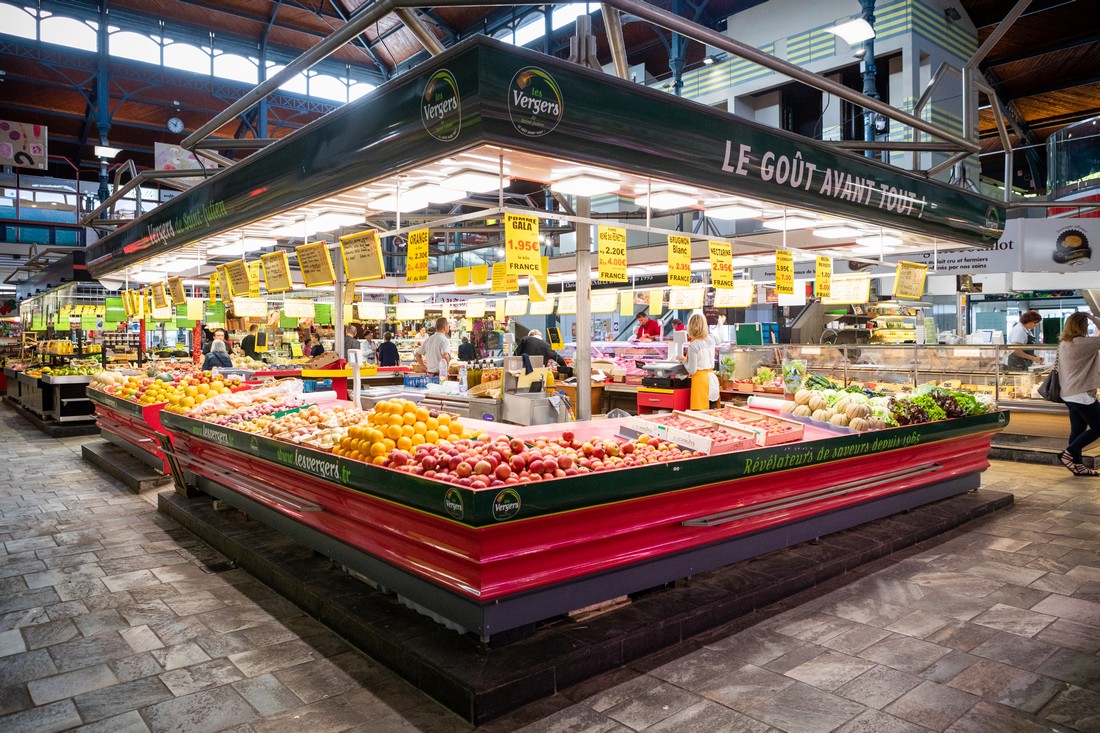About
THE HALLES
Completed and inaugurated in 1874, Les Halles were designed by municipal architect Edmond Bailly.
The latter was inspired by those created by Victor Baltard in Paris, combining iron, cast iron and glass to build one of the largest covered markets of its type.
The construction is typical of the 19th century in terms of materials and sober, slender lines: eighteen cast-iron posts support the immense molded vault, formed by a triple flight of roofs separated by bay windows. The stone base supports a small wall of colored brick into which eight large doors open. The metal framework comes from the Creusot workshops. A mezzanine was added in 1987.
Archeological digs in Place Saint-Remy uncovered traces of the former Collège de la Licorne, a major educational institution in Troyes since the Middle Ages, which previously occupied the Hôtelerie de la Licorne (between today's Rue Gambey and the canal). It was established here in 1617, when the Trojan humanist François Pithou, King's advisor, and his brother Pierre, offered the town a group of houses and their valuable library. The college remained in various forms until 1854. Its half-timbered houses were demolished in 1862.
The keystone from the Pithou portal is on display in the Vauluisant museum.
Major renovation work on the facades and the glass roof of the covered passageway was carried out in 2017.
From March 4 to May 29, 2019, the Halles forecourt has been completely redeveloped. Covering almost 3,500 m², the square is clad in granite paving stones, in the same spirit as the requalification work carried out in the city center.
It hosts outdoor markets on Wednesday, Friday and Saturday mornings in optimal conditions of comfort and safety.
With this redevelopment, the City of Troyes is pursuing its commitment, made some twenty years ago, to providing users with a quality urban space and revitalizing the city center.
A touch of modernity has been added to the Halles forecourt with La Feuille monumentale, a work in bead-blasted stainless steel (bead-blasting is a surface treatment consisting of spraying microbeads onto a stainless steel or aluminum part).
One of the proudest features of this sculpture is that it was entirely produced locally: designed by Thierry and Michèle Kayo-Houël (artists living in Payns), with the help of the metal and ironwork firm Arts et Forges (in La Chapelle Saint-Luc), and Ateliers de Carrosserie Bonenfant (in Buchères), it was finally transported and installed by Trans Manu Machines (based in Bréviandes), all with the support of the City of Troyes.
As you may have noticed, the work is reminiscent of the iconic sculpture of the Heart of Troyes, created by the same artists and installed on the Quai des Comtes-de-Champagne.
But La Feuille isn't just decorative; it's also useful as a railing, concealing the stairwell that serves as an emergency exit from the parking lot beneath the forecourt.
At night, colored lighting reveals the sculpture in a whole new light. The light changes with the seasons: orange in autumn, blue in winter, green in spring and red in summer.
The installation is completed by safety posts and two benches whose stainless steel backrests echo the sculpture's design.
Today, Les Halles is one of Troyes' favorite daily rendezvous: here, you can discover local delicacies and products from Aube (fruit and vegetables, andouillette, cheeses, champagne...) or more exotic ones, in a warm, friendly atmosphere that's particularly lively at weekends.
Opening
| Days | Hours |
|---|---|
| Monday | 08h00 to 13h00 |
| Tuesday | 08h00 to 13h00 |
| Wednesday | 08h00 to 13h00 |
| Thursday | 08h00 to 13h00 and 15h30 to 19h00 |
| Friday | 07h00 to 19h00 |
| Saturday | 07h00 to 19h00 |
Rate
Gratuit


